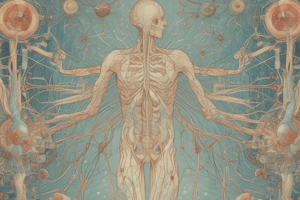Podcast
Questions and Answers
What neurotransmitter is involved in muscarinic transmission to the sinoatrial node?
What neurotransmitter is involved in muscarinic transmission to the sinoatrial node?
Acetylcholine (ACh)
What are the early signs of organophosphate intoxication?
What are the early signs of organophosphate intoxication?
- Diarrhea (correct)
- Seizures
- Miosis (correct)
- Euphoria
What effect does acetylcholine have on sinoatrial node cells?
What effect does acetylcholine have on sinoatrial node cells?
Causes hyperpolarization and inhibition of cAMP synthesis.
Which drugs are often included in treatment for muscarinic excess?
Which drugs are often included in treatment for muscarinic excess?
Barbiturates have a higher ceiling CNS depression than benzodiazepines.
Barbiturates have a higher ceiling CNS depression than benzodiazepines.
What is the mechanism of action for buspirone?
What is the mechanism of action for buspirone?
The primary action of benzodiazepines is to enhance the frequency of __
The primary action of benzodiazepines is to enhance the frequency of __
Match the antiseizure drugs with their specific actions:
Match the antiseizure drugs with their specific actions:
Which of the following is NOT a side effect of buspirone?
Which of the following is NOT a side effect of buspirone?
What is the main reason for careful monitoring of lithium levels during treatment?
What is the main reason for careful monitoring of lithium levels during treatment?
Absorption of lithium occurs primarily in the stomach.
Absorption of lithium occurs primarily in the stomach.
Which of the following can cause hypertension during pregnancy?
Which of the following can cause hypertension during pregnancy?
What condition does dopamine decarboxylase inhibitors primarily help treat?
What condition does dopamine decarboxylase inhibitors primarily help treat?
Study Notes
Here are the study notes:
Muscarinic and Nicotinic Signaling
- Muscarinic transmission:
- Acetylcholine (ACh) released from postganglionic cholinergic axon interacts with M2R in sinoatrial node
- Causes hyperpolarization and inhibition of cAMP synthesis, leading to reduced pacemaker channel opening and L-type Ca2+ channel availability
- Nicotinic transmission:
- ACh released from motor nerve terminal interacts with pentameric nicotinic receptor
- Opens receptor, allowing Na+ influx and producing EPSP, leading to muscle contraction
Cholinesterase Inhibitors Toxicity
- Main source of intoxication is organophosphate used in agriculture and home pest control
- Dominant initial signs: muscarinic excess (miosis, salivation, sweating, bronchial constriction, vomiting, diarrhea)
- Followed by central nervous system involvement (cognitive disturbances, convulsions, coma) and peripheral nicotinic effects (depolarizing neuromuscular blockade)
Treatment of Cholinesterase Inhibitors Toxicity
- Maintenance of vital signs, especially respiration
- Decontamination to prevent further absorption
- Atropine administration to control muscarinic excess
- Pralidoxime therapy to reactivate inhibited cholinesterase
- Benzodiazepines for seizures
Adrenergic Receptors
- α1 receptors: used as antihypertensives, cause less reflex tachycardia
- β blockers: decrease lipid peroxidation and vascular wall thickening, beneficial in heart failure
Sedative-Hypnotics
- Barbiturates:
- Act primarily at GABA receptors, increasing Cl- channel opening
- Well-absorbed, widely distributed, and cross placenta and secreted in milk
- Can produce after-effects, paradoxical excitement, and contraindicated in porphyria and pulmonary insufficiency
- Benzodiazepines (BZDs):
- Act preferentially on midbrain ascending reticular formation and limbic system
- Enhance presynaptic/postsynaptic inhibition through specific BZD receptor and GABAA receptor-Cl- channel complex
- Have high therapeutic index, less distortion of sleep architecture, and lower abuse liability than barbiturates
- Flumazenil: competitive BZD receptor antagonist used to reverse CNS effects of BZD overdose
Antiepileptic Drugs
- Mechanisms of action:
- Modulation of voltage-gated sodium, calcium, or potassium channels
- Enhancement of fast GABA-mediated synaptic inhibition
- Modification of synaptic release processes
- Diminution of fast glutamate-mediated excitation
- Phenytoin: blocks sodium channels, causes depression of CNS (cerebellum and vestibular system), and has reversible cosmetic changes
- Carbamazepine: blocks sodium channels, inhibits generation of repetitive action potentials, and induces its own metabolism
Antipsychotics
- Typical antipsychotics:
- High-potency (haloperidol) and low-potency (thioridazine) agents
- High-potency agents have higher affinity for dopamine receptors and are more likely to cause extrapyramidal reactions
- Low-potency agents have more autonomic effects due to anticholinergic and antiadrenergic activity
- Atypical antipsychotics:
- Include clozapine, olanzapine, quetiapine, ziprasidone, risperidone, and aripiprazole
- Have generally replaced typical agents for initial treatment of first-episode patients
- Clozapine reserved for treatment-resistant patients due to adverse effect profile
Lithium
- Pharmacokinetics:
- Well-absorbed orally, distributed in extracellular water, and penetrates brain
- Excreted mainly in urine, with reabsorption in proximal convoluted tubule
- Adverse effects:
- Neurologic and psychiatric symptoms (tremor, choreoathetosis, ataxia, dysarthria, aphasia)
- Decreased thyroid function
- Nephrogenic diabetes insipidus and polyuria
- Edema and cardiac adverse effects
Parkinson's Disease
- Pharmacological treatment:
- Dopamine decarboxylase inhibitors (carbidopa and benserazide) combined with L-DOPA
- COMT inhibitors (tolcapone and entacapone) to reduce wearing off phenomenon
Let me know if you'd like me to clarify anything!### Methylxanthines
- Caffeine, Theophylline (found in tea), and Theobromine (found in chocolate) are types of Methylxanthines.
Therapeutic Uses
- Theophylline is used to treat Asthma.
- Caffeine is used to treat Apnea of Prematurity by:
- Stimulating medullary respiratory centers.
- Increasing sensitivity to CO2.
- Caffeine is also used to treat Post-Lumbar Puncture Headache.
Psychomotor Stimulants
- Nicotine is the active ingredient in tobacco and the second most widely used CNS stimulant.
- Nicotine is used in smoking cessation therapy.
- Mechanism of action of Nicotine:
- Binds to nicotinic acetylcholine receptor in the CNS.
- Increases levels of dopamine.
- Activates sympathetic nervous system, resulting in release of epinephrine.
Studying That Suits You
Use AI to generate personalized quizzes and flashcards to suit your learning preferences.
Related Documents
Description
This quiz covers the muscarinic transmission to the sinoatrial node in the heart, including the interaction of acetylcholine with muscarinic receptors and its effects on potassium channels and cAMP synthesis.




